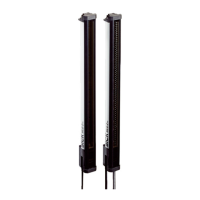4.2 Identifying optimal object position
66
67
68
69
70
71
72
73
74
0 500 1000 1500 2000 2500
Optimale Objektposition (optimaler Abstand Objekt – Sender) in %
Abstand Sender – Empfänger in mm
68,3 %
700 mm
1
2
Figure 16: Identifying optimal object position - example
1
Planned distance between sender and receiver
2
Result for the optimal object position
Identifying optimal object position
1. Select the planned distance between sender and receiver in the diagram.
Example: 700 mm
2. Identify optimal object position using the diagram.
Example: 68.3%
3. Convert optimal object position in mm.
Example: 0.683 x 700 mm = 478.1 mm
4. If needed, calculate the optimal distance of the object to the receiver.
Example: 700 mm – 478.1 mm = 221.9 mm or (1 – 0.683) x 700 = 221.9 mm
Table 9: Optimal object position: Optimal distance between object and sender
Distance between
sender and receiver
Optimal distance
between object and
sender
Optimal distance
between object and
sender
Optimal distance
between object and
receiver
[mm] [%] [mm] [mm]
200 73.4 146.8 53.2
250 72.1 180.3 69.7
300 71.1 213.3 86.7
400 69.8 279.2 120.8
500 69.1 345.5 154.5
600 68.6 411.6 188.4
700 68.3 478.1 221.9
800 68.1 544.8 255.2
900 68.0 612.0 288.0
1000 67.8 678.0 322.0
1100 67.7 744.7 355.3
1200 67.7 812.4 387.6
1300 67.7 878.8 421.2
PLANNING 4
8024643/2019-09-02 | SICK O P E R A T I N G I N S T R U C T I O N | MLG-2 WebChecker
23
Subject to change without notice

